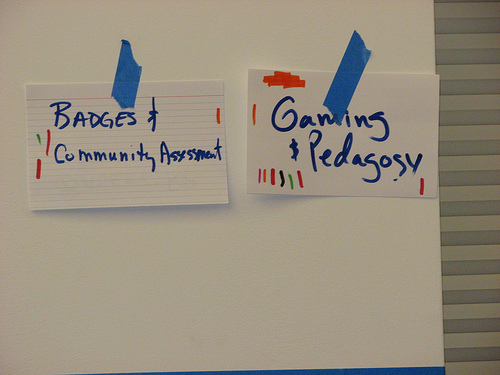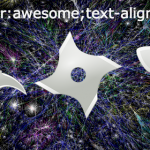Many important ideas have bounced around in my head, my writings, and my worlds during the reclaim open initiative.
For those who do not know reclaim open movement (learn more here) seeks to harness the internet so learning occurs as networked events across innovative spaces. When I look across all the conversations happening around reclaim open I coalesce around one common thread: Design Thinking.
Sure open learning involves innovative use of technologies, and open learning requires a vision that emphasizes knowledge as good for the community and not a good to be commidified. Yet after listening to leaders in the field I have realized the transformative power of open learning emerges from distributed design thinking.
What is Design Thinking?
I am new to this line of inquiry but my nascent reading has pointed me to a history of design thinking that emerged in the fields of architecture and manufacturing. Over time cognitive scientists have (re)desgined many of the ideas. When I translate design thinking into education I borrow heavily from John Chris Jones who put an emphasis on the construct of time:
The main point of difference is that of timing. Both artists and scientists operate on the physical world as it exists in the present (whether it is real or symbolic), while mathematicians operate on abstract relationships that are independent of historical time. Designers, on the other hand, are forever bound to treat as real that which exists only in an imagined future and have to specify ways in which the foreseen thing can be made to exist.
Time. This draws me to the idea of education. In the past we have put so much emphasis on measuring and teaching the past. All this discussion of so-called 21 century skills has made me realize we need to start teaching and assessing for future learning. We need our students discovering solutions to problems we have yet to realize by using technology that does not exiss. In essence we need to teach a generation of designers.
Design for Teaching
A quick google search as this idea coalesced for me revealed I am not the first one to the design think in education party. In fact the map below from IDEO highlights schools that have made design thinking integral to the curriculum.
Teaching as Engineering
My history with examining design in teaching (including stealing the idea for my website tagline) began with my work with David Reinking. Dr. Reinking’s work in literacy research has focused on formative design experiments. As a fellow with Don Leu’s New Literacies Research Lab at UCONN we worked closely with David Reinking’s team to develop learning activities that taught students to read in a learning space that quickly shifted and required each individual reader to construct their own text.
Dr Reinking taught me that engineering, not medical science or agriculture (where many education research paradigms began), serves as the best metaphor for education. We have to start with a pedagogical goal and then identify factors that enhance or inhibit that pedagogical goal.
Teaching as Open
Design thinking not only supports open education but also requires a commitment to open education. I call this the engineering effect. The more we iterate as a community the more we will discover which will lead to even greater iterations and discoveries.
So many scholars have committed to open learning and this pushes design thinking in education. You have the work of Henry Jenkins, danah boyd, Mimi Ito, Mitch Resnick, John Seely Brown, John Greeno, Howard Rheingold, and Daniel Hickey (to name a few in no particular order) that have helped shaped our belief in open learning.
Teachers have also committed to supporting design thinking by pursuing open learning. My Twitter feed overflows with ideas from people such as Paul Allison, Kevin Hodgson, Jerry Blumengarten, Starr Sackstein, Ian O’Byrne, and Karen Fasimpaur. In all honestly I could never list all the teachers who regularly think, lead, fail, and learn in the open.
Design For Learning
I debated delineating design for teaching and design for learning. Teaching and learning are inextricably connected. I decided to make the distinction because we learn without teaching and too often teach without learning. I also think we need a consorted effort to design for future learning. This must resonate in our both our instructional and curriculum design practice.
Instructional Design
In order to create learning that support design thinking we will have to consider spaces that put an emphasis not so much on targets or skill sets but on the learners. We will need an instructional design that focus on civic problems, engagement, motivation, and of course learning. Creating events that support future learning will be critical. We have come a long way since Gagne.
Backward Design
Similar efforts to support design thinking have also translated into classroom practice. I see evidence of this phenomenon in the rise of Wiggin’s ideas of backward design where curriculum tries to emphasize understanding over the skills and the content knowledge. There is much debate as to what we should emphasize skills or content knowledge. I believe we ask the wrong the question. Instead we need to know what pathways get students to deeper learning.
Design for Meaning
Meaning making has always involved the remixing of others ideas. In fact the Greeks originally coined the idea of analysis, literally loosening up, and synthesis, or putting together. In other words “close reading” and “analytical writing” have always involved a bricolage of thinking. The Internet has amplified the speed and reach of these (re)designs of meaning and we see this in the texts we read, the stories we tell, and the languages that emerge.
Design and Text Assembly
As part of my dissertation I spent thousands of hours watching videos of students read online. One of the fundamental characteristics of successful students was engaging in what I called strategic text assembly. These students combined comprehension monitoring strategies and navigational skills to create and read texts that had never existed before. They chose reading pathways that helped them to overcome a lack of background knowledge. They seemed prepared for future learning.
Design and Multimodal Authorship
The signs and symbol systems we use to make meaning have shifted back to the visual, back to the spoken word. The dominance of text, while still the backbone of the Internet, has faded as more traditional non-verbocentric practices have reclaimed a strong position in meaning making. As researchers and educators we need to understand how meaning making when we engage in transmedia and transliteracies practices.
Design and Web Literacies
I am glad all the early talk of Web 2.0, the read/write web, and WYSIWYG editors has faded to the background. I am glad to see such a focus on teaching students computational thinking and coding. We will need cadres of learners who can speak in the language of the web.
Distributed Design Thinking
You do not need to know how to code to be a designer and not all coders, engage in design thinking. The same reads true for educators. That is my other take away from the reclaim open movement. You can not do design thinking or open education alone.
The issues we face as researchers and educators are too big. The problems too complex. If students are to imagine a future and create things that yet to exist we need to encourage real-time problem solving and emergent literacies in collaborative teams. You can be the idea guy, the coder, the artistic designer. The role really does not matter. As long as students, and us in general, have a shared vision and are willing to reach that goal through multiple pathways of knowledge we will support design thinking in education.






